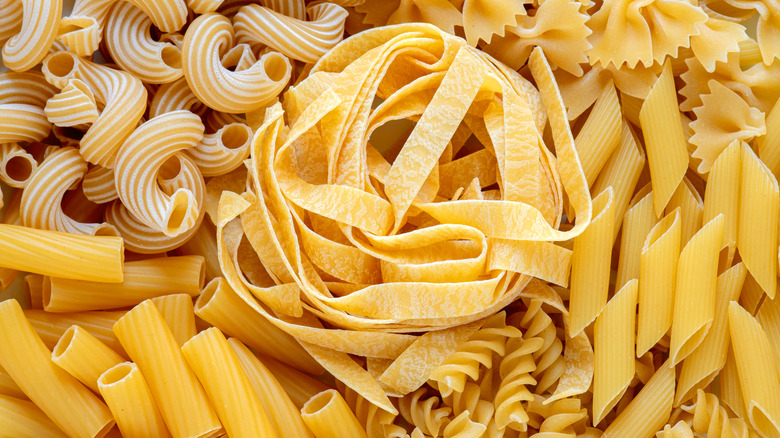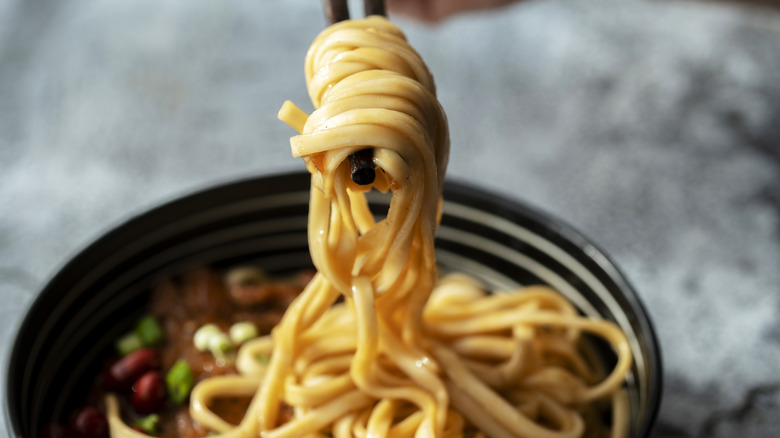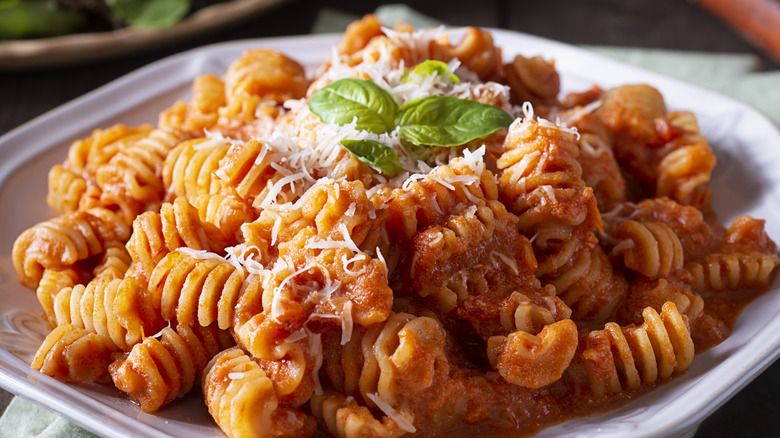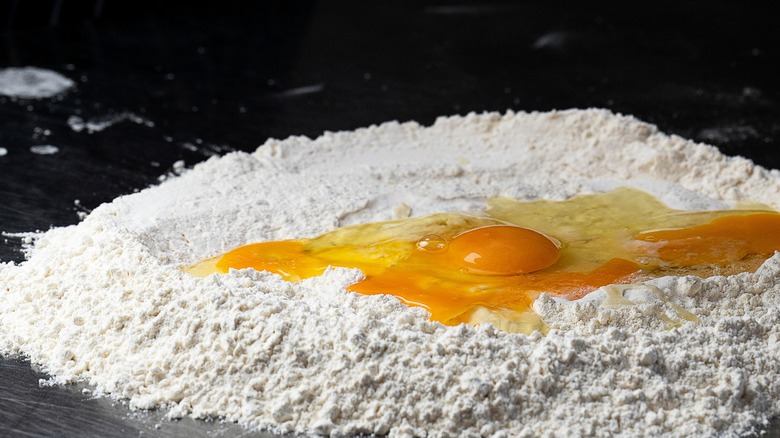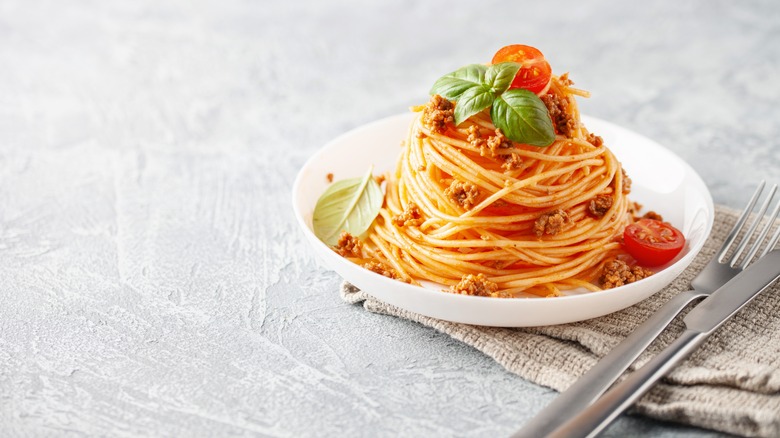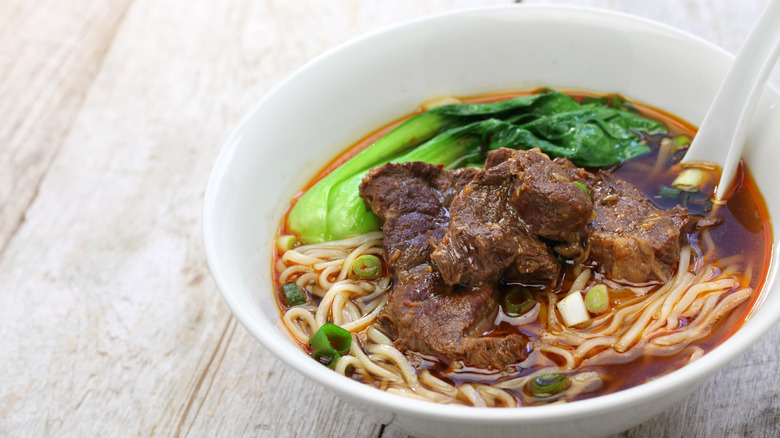What's The Difference Between Egg Noodles And Pasta
There's something very comforting about noodles, whether it be a plate of pasta, a quick ramen fix, or a nourishing bowl of chicken noodle soup. Finding a catch-all term can be tricky; after all, there is a subtle difference between noodles and pasta. A sturdy, unleavened dough of variable flour is molded, cut into fun shapes, and subsequently boiled for enjoyment. If you start to examine all of its variations, and many fascinating details emerge.
A particularly interesting example are egg noodles. You likely know them as the darker yellow, wide variety seen at the grocery alongside pasta. Perhaps you've employed them in a classic chicken casserole, noting their shorter cooking time and softer consistency. So, other than their eponymous egg constituency, what makes them distinct from pasta?
Turns out, it's a complicated question, and one that really sifts through the specifics of noodle creation. Pasta is all about a semolina flour base, although egg noodles can sometimes involve the flour, too. Noodles necessitate a long ribbony shape, and while pasta can be long, it also takes on more varied forms. And although a plate of pasta undoubtedly warrants associations with Italy, egg noodles are found both all over the world.
What are egg noodles?
Egg noodles refer to many different doughy ribbons all tied together by their namesake: Eggs. The ingredient can be integrated in many forms, from only the yolks to entire eggs. This addition typically lends the food a yellowish tinge, accompanied by a more decadent, rich taste. The utilized flour can further alter the flavor and composition, creating noodles that range from oat-based to Kosher potato flour noodles. Noodle doughs with eggs exist in many culinary contexts.
As with other noodle types, this variety is cut long, oftentimes with wide and flat dimensions. It's available both dried and fresh, and can be relatively easily crafted at home. Egg noodles have a higher ratio of eggs than other pasta types, which lends them softness, and a more pliable texture. As a result, they'll have some distinct culinary qualities, so consider some special tips when cooking with egg noodles. You'll want to keep an eye on their less rigid nature and select dishes that meld well with softer noodles. This, when combined with their egg flavor, lends them a special comforting nature.
What is pasta?
Few foods have the iconic status of pasta. The name refers to a broad range of products with well over 40 types, each with a specific way you should use them. It's a staple that's so ubiquitous, it can be tricky to pin down its most intrinsic qualities. Sure, it's typically dried, packaged in a box, and boiled, but how does that distinguish the food from other noodle — especially egg-laden — types?
In its most traditional form, pasta is crafted from semolina flour, which is specifically made from durum wheat. Most dough recipes only employ a few additional ingredients — water, flour, salt, and occasionally eggs which are more often used in fresh doughs. Note that if you're buying dried pasta from the store, it's likely egg-free. Modern interpretations sometimes alter the composition of pasta, using alternative flours to craft gluten-free types, or adding flavor and color to fresh pasta with ingredients like herbs, vegetables, and squid ink.
Pasta takes on a wide array of shapes, crafted into everything from bowties to sheets and the beloved childhood alphabet letters. It's best cooked to a chewy al dente, and served with a simple but flavorful sauce, with an optional vegetable and meat pairing. Such culinary qualities stem from pasta's more flour-centric composition, which makes it chewier in composition.
Egg noodles are typically softer than pasta
Since both terms encompass many compositions, there's a level of subjectivity to untangling egg noodles from pasta. After all, some pasta types do incorporate eggs, so the ingredient can't function as a differentiator. And since noodles can come together with any flour, if they employ semolina, then it's a kind of pasta. Investigating the nuance in their creation evinces their detailed complexity.
To fit both criteria, the foodstuff needs a semolina-flour based dough, made with eggs, and cut into long ribbon-like shapes. The more eggs are introduced, the greater the resultant pasta texture alters. The whites enhance the pliability, while the yolks enhance with richness. As the dough's egg ratio increases, the softer it turns, and in turn the formation of small shapes becomes more difficult.
As a result, some suggest that as the ratio of egg to flour increases, the more the creation falls into the egg noodle camp. It's a sliding sale with no clear tipping point, but one that nonetheless considers their textural difference — softness is a sign of a more noodle-like quality.
Pasta interlinks with Italian cuisine
Just say the word pasta, and a particular cuisine comes to mind: Italian. From Rome's pasta e ceci, to all the best Sicillian pasta dishes, the food is strongly associated with the Mediterranean nation. Of course, it's not the only country where the food's prepared. Ridged fusi is enjoyed alongside hearty dishes in Slovenia and Croatia. Greek cuisine offers its selection of pastas, like kritharaki and creamy, comforting trahana.
Plus, cuisines influenced but Italy also evolved into their own renditions, like the many historic Argentine pasta establishments serving renditions with local flavors. Not to mention all the beloved classics of Italian-American cuisine, like baked ziti, and spaghetti and meatballs. Pasta's iconic status can be partly attributed to its shelf stability. The durable drying process was perfected by Italians, intertwining the foodstuff with Italian brands. Egg noodles are best consumed quickly after forming and take on more variable forms worldwide. As a result, they're more camouflaged in their culinary uses.
Egg noodles are found across the world
With a rich, flavorful dough, egg noodle creations appear in an enormous range of culinary contexts. Some beloved Asian noodle dishes, especially in China and South East Asia, are concocted with egg noodle varieties. If you're eating a serving of tender Taiwanese beef noodle soup, a delicious garlicky lo mein, or a batch of stir-fried Malaysian mee goreng, you're eating egg noodles, my friend.
Travel westward to Central Asia and Turkic cultures, and you'll find the egg-based kesme. This version is shorter and thicker, employed in the national soup dish of Kyrgyzstan, and also enjoyed in the cuisines Iran, Afghanistan, and Turkey. Typically, you'll find it in a hearty meat broth, served with root vegetables and tomatoes.
Egg noodles can also be found throughout Europe. The dish is a culinary favorite of Ashkenazi Jews, serving as the foundation of noodle kugel, which has a debated origin. Meanwhile, in Poland, you'll find egg noodles served with cottage cheese and sour cream, while Serbians craft sweet renditions with dried fruit and walnuts. In Germany, the elongated shape is abandoned, with the dish spaetzle using teardrop-shaped egg noodle morsels. And to take it full circle, egg noodles are enjoyed in Italy, too. After all, their distinction from pasta may be slight, but the appeal of both types is enormous.
